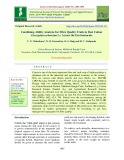
Transgressive segregation analysis
-
Soybean is economically the most important bean in the world, providing vegetable protein for millions of the people and ingredients for hundreds of chemical products. The aim of this study was to identify the superior transgressive segregants and estimate the correlation coefficient between seed yield, and yield components. Six generations of a crosses were evaluated at Botany Section Farm, College of Agriculture, Dhule (Maharashtra) during Kharif, 2019.
 8p
8p  caygaocaolon11
caygaocaolon11
 21-04-2021
21-04-2021
 14
14
 2
2
 Download
Download
-
The present investigation was undertaken with 30 rice genotypes to estimate the nature and magnitude of genetic divergence for yield and nutritional traits. The 30 genotypes were categorized into six clusters based on D² values using agglomerative hierarchical clustering complete linkage based on Mahalanobis distance. Cluster I was largest comprising of nine genotypes followed by cluster III and IV comprising of seven and six genotypes respectively.
 13p
13p  chauchaungayxua11
chauchaungayxua11
 23-03-2021
23-03-2021
 14
14
 2
2
 Download
Download
-
Progenies from a cross between ‘Gopaldoddiga’ and ‘ARB6’ cultivars were selected on the basis of combining ability analysis to study the genetics of transgressive segregation for zinc content and agronomic traits using augmented designs. Results revealed the presence of general combining ability and specific combining ability effects, and the parents were found to be good general combiners for zinc in grains, 100 grains weight and grain yield per plant.
 15p
15p  cothumenhmong5
cothumenhmong5
 17-05-2020
17-05-2020
 22
22
 2
2
 Download
Download
-
Genetic variability and diversity play a major role in framing successful breeding programme. It is evident that genetically diverse parents are likely to produce high heterotic effects and yield desirable transgressive segregants. Keeping this in view, the present study was conducted to evaluate nature and extent of genetic variability and diversity in Indian mustard [Brassica juncea (L.) Czern. & Coss.].
 13p
13p  trinhthamhodang5
trinhthamhodang5
 16-05-2020
16-05-2020
 13
13
 2
2
 Download
Download
-
An experiment was conducted involving 10 diverse parents and their 24 hybrids obtained by line x tester mating design laid out in randomized block design with three replications. The analysis of variance revealed presence of ample variability for fifteen quantitative traits studied.
 9p
9p  nguathienthan4
nguathienthan4
 18-04-2020
18-04-2020
 14
14
 1
1
 Download
Download
-
Pearl millet is a cross pollinated crop and 5th most important crop after rice, wheat, maize and sorghum. It is dual purpose crop which is mainly grown for food and fodder. It is well adopted to adverse environmental conditions. The experiment was conducted at Bajra Research Area, Department of Genetics and Plant Breeding during Kharif, 2017 and at Bajra Research Area, Department of Genetics and Plant Breeding and Dryland section of Department of Agronomy, Chaudhary Charan Singh Haryana Agricultural University, Hisar during Kharif, 2018.
 4p
4p  caygaocaolon2
caygaocaolon2
 11-03-2020
11-03-2020
 10
10
 1
1
 Download
Download
-
Chickpea, a cool season legume crop of the family Leguminosae and of the genus Cicer, is the world’s largest pulse crop. This crop has high productivity and holds prominent position in the international food grain trade. An experiment was conducted to identify the transgressive segregants for yield and yield contributing characters in F2 population of three crosses in chickpea. In most of the tansgressive segregants, in each of the three crosses, better parent yield was transgressed with transgression of one or several other characters.
 7p
7p  caygaocaolon3
caygaocaolon3
 27-02-2020
27-02-2020
 18
18
 0
0
 Download
Download
-
The present experiment was carried out using twenty-nine elite breeding lines from Station Yield Trial - Slender Grain materials along with three check varieties at the Rice Research Station, O.U.A.T., Bhubaneswar in kharif- 2016. A part of the research was to study the genetic divergence among the breeding lines used in the experiment. The D2 values obtained from the divergence study ranged from 3.36 between OR2675-6-4 and OR2676-2-5 to 2518 between OR2675-2-1 and Samba mahsuri.
 8p
8p  nguathienthan3
nguathienthan3
 27-02-2020
27-02-2020
 14
14
 0
0
 Download
Download
-
An experiment was conducted to estimate genetic variability, heritability and genetic advance expressed as per cent of mean in F2 population of two crosses viz., DCS-47-1 × PL-1 and DCS-47-1 × PGCP-12 in cowpea. Analysis of variance revealed significant differences among the segregants tested for all the sixteen characters. High PCV and GVC were observed for number of secondary branches per plant, leaf to stem ratio, number of pods per plant, green fodder yield per plant, green fodder yield per metre row length and stover yield per plant in both the populations.
 9p
9p  cothumenhmong3
cothumenhmong3
 22-02-2020
22-02-2020
 19
19
 0
0
 Download
Download
-
The adequacy of different genetic models and nature and magnitude of gene effects responsible for the expression of seed yield and important yield contributing characters were studied in mustard. 6 generations of two crosses viz; MRNJ 88-1 X JMWR 9081-1 (Family A), MRNJ 131 X JMWR 9081-2 (Family B) sown in Compact Family Block Design were investigated.
 7p
7p  cothumenhmong3
cothumenhmong3
 22-02-2020
22-02-2020
 17
17
 1
1
 Download
Download
-
A set of 75 pigeonpea genotypes were evaluated during kharif 2017-18, to determine the genetic divergence among these genotypes for 17 seed yield and quality characters and to identify divergent parents. UPGMA method of Hierarchical Cluster analysis used with City Block distances grouped these genotypes into ten distinct clusters comprising of one to twenty genotypes. Maximum inter cluster distance was observed between cluster II and VIII followed by cluster II and VI and cluster II and IX.
 8p
8p  chauchaungayxua3
chauchaungayxua3
 07-02-2020
07-02-2020
 9
9
 1
1
 Download
Download
-
The present investigation was undertaken with a view to generate genetic information on gene effects for 14 quantitative traits in brinjal through generation mean analysis. The experimental material consists of six generations, namely P1, P2, F1, F2, B1 and B2 of four crosses in brinjal viz., AB-15-07 x GJLB-4 (cross 1), JBR-14-07 x Pant Rituraj (cross 2), NSR-01 x Swarnmani Black (cross 3) and NBR-14-05 x GJB-03 (cross 4). The results indicated that the magnitude and type of gene effects differed for the same trait in different cross combinations.
 10p
10p  chauchaungayxua3
chauchaungayxua3
 07-02-2020
07-02-2020
 12
12
 0
0
 Download
Download
-
An experiment was undertaken by utilizing forty finger millet genotypes for eleven yield and yield contributing characters to assess genetic divergence. The analysis of variance has shown that there was significant variation among the genotypes in all the traits. The multivariate analysis carried out using Mahalanobis D2-statistics, indicated wider genetic diversity in the genotypes of finger millet.
 13p
13p  chauchaungayxua3
chauchaungayxua3
 07-02-2020
07-02-2020
 14
14
 1
1
 Download
Download
-
Fifty-six germplasm lines of green gram [Vigna radiata (L.) Wilczek] were used to determine the extent of genetic diversity using Mahalanobis D2 statistic. The analysis was carried out for 20 quantitative traits. The D2 statistic performed on 20 quantitative traits grouped all 56 genotypes into eight divergent clusters. Cluster V (8559.766) had maximum intra-cluster distance while inter-cluster distance was highest between clusters III and VI(329997.
 9p
9p  chauchaungayxua3
chauchaungayxua3
 07-02-2020
07-02-2020
 11
11
 1
1
 Download
Download
-
Cotton is one of the most important fiber and cash crop of India and plays a dominant role in the industrial and agricultural economy of the country. Fifty six crosses with fifteen parents and four checks viz., PKVDH 1,PKVSuvarna, NACH 12 and PA 255 were grown in Randomized Block Design with two replications during kharif, 2016 at three locations viz.,Cotton Research Station, Mahboob Baugh Farm, Parbhani (L1), Cotton Research Station, Nanded (L2), and Agricultural Research Station, Badnapur (L3).
 12p
12p  nguaconbaynhay3
nguaconbaynhay3
 07-02-2020
07-02-2020
 11
11
 0
0
 Download
Download
CHỦ ĐỀ BẠN MUỐN TÌM








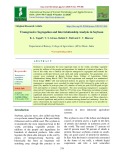


![Genetic variability and divergence studies for seed yield and component characters in Indian mustard [Brassica juncea (l.) Czern. & coss.] over environments Genetic variability and divergence studies for seed yield and component characters in Indian mustard [Brassica juncea (l.) Czern. & coss.] over environments](https://tailieu.vn/image/document/thumbnail/2020/20200516/trinhthamhodang5/135x160/8491589618370.jpg)
![Analysis of combining ability and gene action in Indian bean [Lablab purpureus (L.) Sweet] Analysis of combining ability and gene action in Indian bean [Lablab purpureus (L.) Sweet]](https://tailieu.vn/image/document/thumbnail/2020/20200418/nguathienthan4/135x160/7251587226922.jpg)
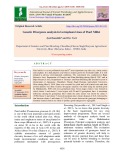
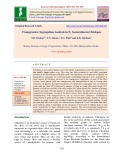
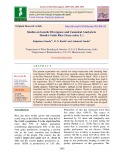

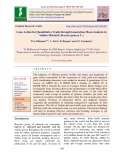
![Genetic diversity for quality traits and seed yield in pigeonpea [Cajanus cajan (L.) Millsp.] Genetic diversity for quality traits and seed yield in pigeonpea [Cajanus cajan (L.) Millsp.]](https://tailieu.vn/image/document/thumbnail/2020/20200207/chauchaungayxua3/135x160/7631581049748.jpg)

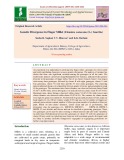
![Genetic diversity analysis through D 2 statistic for quantitative traits in germplasm lines of green gram [Vigna radiata (L.) Wilczek] Genetic diversity analysis through D 2 statistic for quantitative traits in germplasm lines of green gram [Vigna radiata (L.) Wilczek]](https://tailieu.vn/image/document/thumbnail/2020/20200207/chauchaungayxua3/135x160/3821581047341.jpg)
